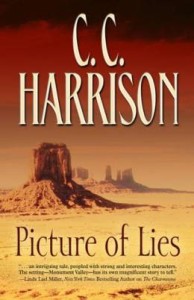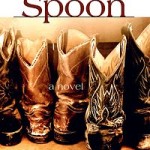My guest today is C. C. Harrison, author of hundreds of articles and short stories as well as novels. When she’s not writing, reading, or working out at the gym, she can be found in the mountains of Colorado or in some far-flung corner of the Southwest. She currently lives in Arizona, the setting for Picture of Lies. She also writes western historical romance under the name of Christy Hubbard.
Thanks so much for being here today, C.C.
————————-
Thank you, Patricia, for inviting me to be a guest on your blog. I’m fascinated by the writing process and have always been interested in knowing how authors develop their books. I wanted to know specifically, step by step, what did they do? Eventually I realized there was no one way to write a book, and after my second book was published, I discovered a process that works for me – index cards. My critique partner at the time called them “cooking cards,” so here I’ll share with you my recipe for cooking a book. Follow directions carefully, then ENJOY!
C. C. HARRISON’S QUICK AND EASY WAY TO COOK A BOOK
 PREPARATION TIME: Varies; days, weeks or months.
PREPARATION TIME: Varies; days, weeks or months.
ASSEMBLE INGREDIENTS: Gather the following together in your mind or on paper-
– A story idea – Just a nugget will do, but more is better
– Character names – Physical descriptions can come later, but you definitely need names
– Setting—Geographic location, or specific city/town. It’s okay to make up a place name.
– Type of journey – Someone seeking something, keeping something, or getting get rid of something. Story goals are many, choose whichever appeals to you.
– A couple of major conflicts
– Ending – Yes, you need a general idea of an ending so you know what the finished product looks like.
MIX:
Combine all the above ingredients and stir gently in your head until the story begins to burst out of you.
THEN IMMEDIATELY:
Write a list of 20 (or more) events you want to happen in your story. This gets the creative juices flowing. Brainstorm!
ARRANGE ON COOKING CARDS:
Take a thick stack of 4”x6” index cards, and using a separate card for each, jot down story events, plot points, turning points, scene ideas, bits of dialogue, critical and/or emotional character reactions and stumbling blocks. Leave plenty of white space on each card so you can add more later. You WILL want to add detail as the writing progresses. Use back of card as needed.
SORT:
When you have a stack of cooking cards one-half to three-quarter inches thick (AND NOT BEFORE), lay them all out in no particular order on your bed or your dining room table. Carefully read each one. Then and only then, pick up one card at a time in the general sequence you think the events should appear in your book. By now, you will instinctively have a feel for this. Don’t worry about getting this part wrong, it can always be fixed later by rearranging the cards, which is why when you have your cards stacked in a general order, you will number them in the upper right hand corner IN PENCIL.
Wrap a rubber band around your cooking cards, or use a giant pinchy clip. Use the information on these cards one at a time to write your book, and you will always know where you are going even if you don’t always know how to get there. Shovel in huge amounts of creativity, triumph over innumerable challenges, and you will have a book.
This process is flexible enough to insert new ideas during the writing while still staying on track and moving in the right general direction. I revise my manuscript as I go, scene by scene, sometimes page by page, so when I reach the end, I have a nearly completed book requiring only minor revision and polishing, but no rewriting.
I used the process I described above to write my new book, Picture of Lies, a Five Star/Gale/Cengage October release. It’s the story of investigative journalist Keegan Thomas who travels to Monument Valley on the Navajo Indian Reservation seeking the whereabouts of people in an old photograph found in her grandfather’s belongings after his death. A child in the photo was kidnapped by missionaries and never returned. Keegan’s search for this child leads to a web of deception stretching back two generations, and the truth she learns about her own family is the most shocking betrayal of all. Nothing is true in the Picture of Lies.
————————-
Thanks for this fun and educational post, C.C.
C. C. Harrison’s award-winning books include, The Charmstone, a mystery set in Monument Valley on the Navajo Indian Reservation called “An important book!” by Tony Hillerman. Next came Running from Strangers, and Sage Cane’s House of Grace and Favor (written as Christy Hubbard), which was honored at the Aspen Institute as a finalist in the 2010 Colorado Book Award. Picture of Lies, another Monument Valley mystery, was released on October 21, 2011. Her fifth book is Cemetery Trees, a Michigan mystery. She is currently at work on The Missing Girl.
To learn more about C.C. Harrison and her books, visit her website and her blog.






Thanks for sharing from another five star author. We both have books being released in Oct. Your “cooking cards” are clever & quite unique. They remind me a little of the “Story board”method.
Dipping in a bit late to say hello to another Five Star author. I enjoyed reading your method of cooking up a story. I got quite a kick out of your “cooking cards” – I’ve never heard that term for index cards before, but it makes perfect sense.
wishing you all the best with your release!
Maggie Toussaint
DEATH, ISLAND STYLE coming soon
John, maybe your colleague was onto something. I grew up on a farm, so it’s logical I’d become a pantser. It’s hard to overcome one’s upbringing.
Great idea. A colleague once said that there were two kinds of teachers: farmers and manufacturers. The pantser – planner analogy sounds similar. I’ve always been more a farmer – just plant the seeds and let them grow. I’ve never been able to force students or ideas to to what I want. Now, though, I want to try this out. Thanks for the ideas.
Jenny, Alex, and Susan — I usually type my “outline” in a long narrative summary or a chapter/scene narrative and have little notes scribbled all over the place from my calendar to Post-Its. Not very organized.
Jacqueline, thanks for dropping by. We always enjoy seeing our Five Star friends here.
Dean, I assume your offer is for C.C. I don’t cook. 🙂
Great…now that I’ve got a great recipe, I need to find a cook to match! Any offers? You cook, I’ll clean!
Thanks Pat and C.C.
I enjoyed reading your post, C.C.
You’ve got a very interesting method for cooking a book. Thanks for sharing.
Thanks for fun description of how to do this writing stuff. The notecard idea makes it all seem so easy and orderly. I tried working with cards some time ago but when I wrote down a short idea I just kept writing. I couldn’t seem to stop. I need more discipline, I guess.
That would so mess me up! I plan the whole thing from start to finish in my head and then write down a detailed outline. I couldn’t do it all out of order.
Fun post! I love the idea of cooking cards. I typically make lots of notes in various spiral notebooks, which isn’t the greatest system around.
Thanks to so many for dropping in so early this morning. Yes, Pat, I thought the same thing, and had to smile to myself at Diane’s thoughts. Pantsers are appalled at the way I put my books together.
I teach beginner/newly published writer workshops and get mostly pantsers, or writers who say they are. It gives them shudders to hear me talk about planning a book, but I must say, I’ve converted quite a few pantsers, and they’ve thanked me later when I’ve run into them at conferences.
But, Diane, you proved my original point. There is no ONE way to write a book, there are MANY WAYS to write a book. That’s why I’m so interested in how other writers do it. I hope some writers join in today to tell us about their process. I’d really like to know. I had tried several methods before I hit on the one that works for me.
But I’m always on the lookout for something better.
(If this post publishes twice, it’s because the first one disappeared before I hit publish. Sorry.)
Hi Donna — some of us need all the help we can get. C.C.’s post has convinced me to put a stack of cards by my keyboard to use for notes during NaNoWriMo. I may come out of this with a whole new outlook on putting a story together.
Diane — you must be a pantser. I think I’m in transition from pantser to planner.
Good morning, Margot. You did have to mention blizzard…the official snowfall for my town was 8″ but we got closer to 10″ at my house.
Anyway, I know a couple that creates recipes and enters contests such as the Pillsbury Bake-off, and I suspect their method is much like this. The creation, trial and error, and revision process must be very similar to what we do when writing a story. Makes good sense to me.
Pat – Thanks for hosting C.C.
C.C. – Thanks for sharing your way of plotting and planning a novel. I think for all of us a story begins with trying to capture a blizzard of ideas and then putting them in some coherent order. An interesting analogy to recipes…
I don’t think I could plot a story that way.
Hi Pat,
Thanks for hosting C.C.
Using cooking cards to write a book sounds like a great way to get started and keep going.
Donna V.